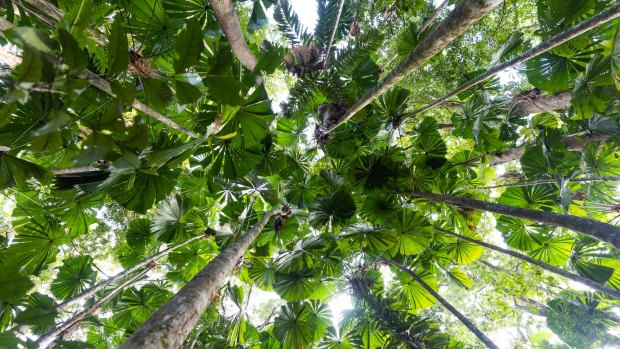This was published 2 years ago
Daintree rainforest wildlife: Pythons a problem without their natural predator - us
By Lee Tulloch

The Daintree: Pure magic.Credit: Jason South
They are proud of their crocs in northern Queensland. Crocodile tours. Crocodile farms. Croc burgers on the menu.
I have a healthy respect for the crocodile, especially one that's closer than 500 metres. But I'm not sure why they capture so much attention, especially as they're far from the only interesting wildlife in this part of the world.
If you venture into the ancient Daintree rainforest there's a spider that disguises itself as bird poo to deceive predators. It co-inhabits the forest with other extraordinary examples of nature - brilliant green tree frogs, fruit-sucking moths, fierce cassowaries, dragons, kingfishers, owls, bandicoots, blue neon bees, flying foxes and spiky katydids. There are also 4000 species of plants, including cascades of luminous lichen, sprays of orchids and a white fruit that turns fluorescent when it drops on the forest floor so that it's detected by the birds and animals that spread its seeds.
And there are pythons. Neil Hewitt wants to discuss pythons.
In another life, Neil was a teacher from Victoria. Now he lives in the depths of the Daintree, along with his extended family, on freehold land he bought after the Daintree was inscribed into the World Heritage List in 1988. The previous owner planned to log the land but was stymied by the new conservation regulations.
Having travelled and taught in remote communities in Australia, Neil developed a respect for Indigenous cultures and their land management skills. Now his singular responsibility, he says, is to protect the forest and share what he has learnt.
Over many years he has documented this breathtakingly diverse natural world, which he published in a massive coffee table book called A Stray Liana. And he conducts small, personal tours of his bit of paradise, which straddles Cooper Creek.
A walk with Neil through the astonishing landscape is intense. It seems as if he knows every tree and vine on his property, as well as the location of ancient Indigenous carvings in the forest bed. It's hard to keep up with his barrage of fascinating information as you go deeper and deeper into the forest.
Some random facts I learnt from Neil: rainforest trees are covered in strangler vines. While they look as if they're killing the trees, they're in fact creating a marvellous structure that holds the forest together and can harness the internal power of cyclones when they hit.
Dragon trees were thought to be mythological until the 1970s, when a cow from one of the farms that used to exist on the land died from eating a large, toxic seed that was found to be from this primitive plant.
The beautiful fan palm grove in the heart of the property includes trees that are 1500 years old – you can tell from the height they grow, one metre a year.
The boss lady of the forest is the female cassowary. She lays her eggs and then supervises the male, who nests the eggs until they hatch, which may take six weeks. In that time, the female does not permit him to get up or even eat or drink.
Then there are the pythons.
In the upper reaches of the 180-million-year-old rainforest live thousands of pythons. (Luckily, they don't often venture down from the treetops.) These different species of python, predominantly the Amethystine Python, are now the apex predator of the forest, snacking on warm blooded prey like the flying foxes and micro bats and pushing the little mammals to extinction.
That's a huge problem for the ecosystem. The flying foxes are essential to disseminate seeds throughout the forest. For thousands of years the python numbers were controlled. And then, about a century ago, the major hunters of python, the local Kuku Yalanji people – descendants of a diminutive people adept at tree-climbing – were forcibly evicted from the land of which they were custodians.
Over 70,000 years a refined Indigenous culture managed the rainforest. Without them, it's all out of balance, and the pythons, along with feral pigs, rule the rainforest, destroying diversity. According to Neil, the rainforest suffers from "the plight of nature robbed of its humans".
This is something we don't always think about – how we humans can be a beneficial part of the ecosystem, not just its destroyer.
If you're travelling up to Tropical North Queensland over summer, give the crocs a miss and take a detour into the rainforest. It's pure magic.
lee.tulloch@traveller.com.au
Sign up for the Traveller Deals newsletter
Get exclusive travel deals delivered straight to your inbox. Sign up now.